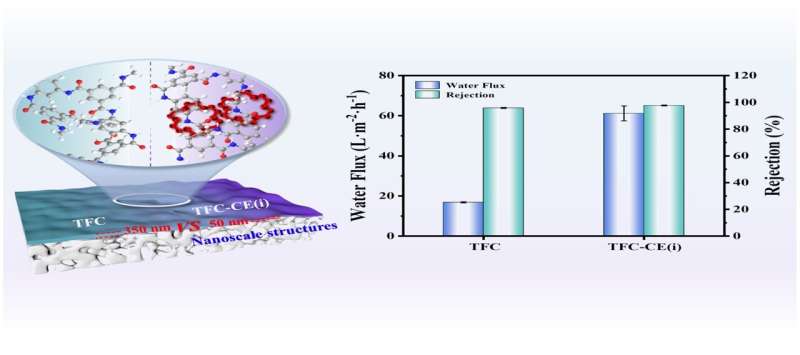The addition of crown ether through a polymerization process to pristine polyamide membranes used for desalination was found to increase performance in controlled lab settings, offering promise for a possible breakthrough in higher-performing reverse osmosis desalination technology. Credit: Nano Research, Tsinghua University Press
A multinational team of researchers have developed a process that builds on the success of current reverse osmosis processes that remove salt from seawater. Researchers led by Professor Heqing Jiang, of the Qingdao Institute of Bioenergy and Bioprocess Technology, Chinese Academy of Sciences published their findings Nov. 18, 2022 in Nano Research.
At the heart of reverse osmosis processes used for desalination is a thin film composite called a polyamide membrane.
The polyamide membrane has dominated the market for desalination applications deployed where fresh water is scarce, but the introduction of nanoscale structures may represent a leap forward in technology—which is desperately needed in parts of the world as fresh water shortages worsen.
The fresh water shortage and water pollution, caused by rapid population growth and industrial expansion, has become a serious issue, according to Jiang and his co-authors, who hail from institutions in Egypt, Saudi Arabia, and China—all places with pockets of fresh water scarcity.
Jiang and his colleagues conducted the creation of a multifunctional crown ether interlayer within a polyamide membrane, with the hope it would improve separation performance.
"With the assistance of the crown ether interlayer, the polyamide membrane obtains more nanoscale structures on the membrane surface and a nanoscale thickness, which are conducive to enhancing water performance, because the former increases the effective filtration area, while the latter greatly reduces the mass transfer resistance," Jiang said.
"Moreover, nanoscale pores in the membrane can provide high-speed channels to promote water transport. The developed polyamide membrane demonstrates a superior water permeance over the pristine polyamide membrane while maintaining a comparable salt rejection."
The research comes amid other efforts to develop microstructures that can be added to the polyamide membrane to boost reverse osmosis efficiency, providing more potable water throughput per given filtration unit.
In this case, the researchers prepared the membrane by spraying crown ether on the substrate impregnated with amine aqueous solution, then further treated with a trimesoyl chloride/hexane solution to create a polymerization reaction, leading to the resulting nanostructures and greatly adding to the membrane's effective surface area, as well as a significant decrease in thickness.
"The novelty of this work is the development crown ether interlayer-modulated polyamide membrane, which shows excellent separation performance benefitting from the construction of nanoscale microstructures," Jiang said.
"The crown ether interlayer not only decreases the interfacial polymerization reaction rate, but also controls the reaction in the confined space, so an ultrathin and uniform polyamide layer with regular nanoscale structures is formed. The separation performance of this kind of membrane is better than the native polyamide membrane (our control), which indicates that constructing an interlayer is a better strategy to modulate the microstructure and performance of the polyamide membrane."
Multiple techniques were used to evaluate the test membrane samples, including infrared spectroscopy and X-ray photoelectron spectroscopy. Jiang said a next step in this research is investigating whether these positive results are repeatable and scalable, information needed to assess the technology's potential for future commercial viability.
"Membrane-based separation technology is vital to industrial applications, especially in small molecules/ions separation," he said.
"High-performance membranes are a permanent pursuit because not only can they increase separation quality, but they can also improve separation efficiency. Considering the efficient modulation of crown ether on microstructures of polyamide membranes and the prominent enhancement of separation performance, we will explore the feasibility of large-scale membrane fabrication and investigate the influence of crown ether on separation performance using real seawater as a feed solution."
"It is also important to expand the applications of polyamide membranes in organic solvent separation, gas separation, and other separation processes."
More information: Yanyu Zhao et al, Crown ether interlayer-modulated polyamide membrane with nanoscale structures for efficient desalination, Nano Research (2022). DOI: 10.1007/s12274-022-5196-3
Journal information: Nano Research
Provided by Tsinghua University Press
























